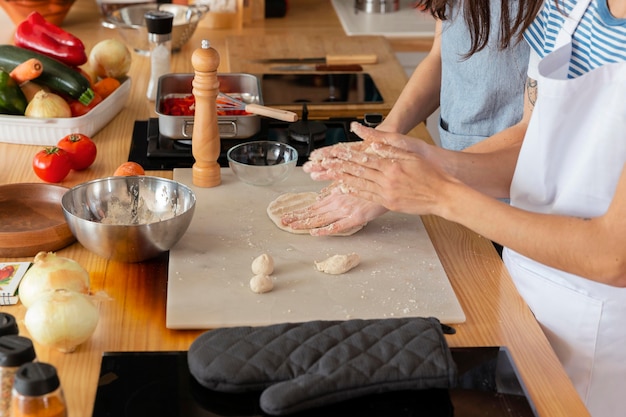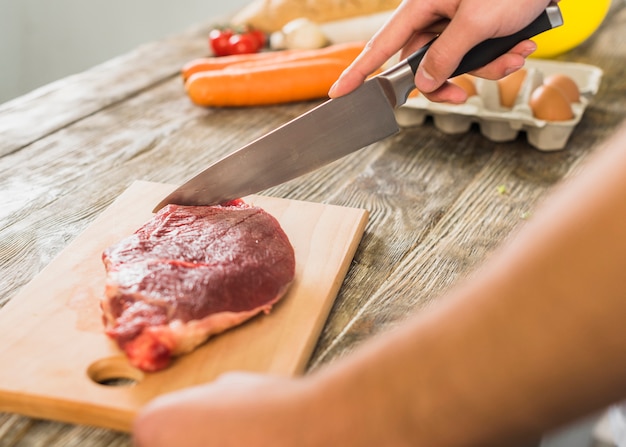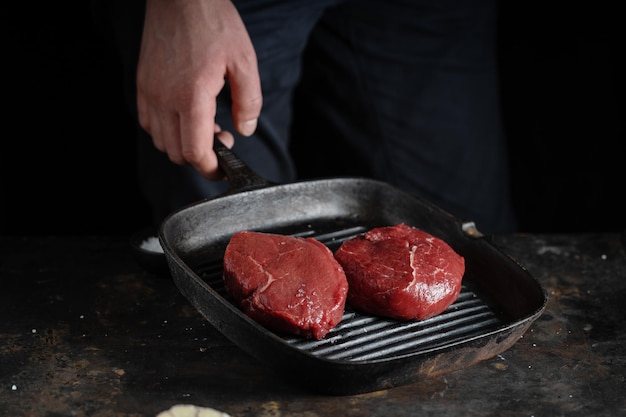Ah, meatloaf. A dish that evokes memories of childhood dinners, family gatherings, and warm, comforting aromas filling the kitchen. But when you're tackling a 2lb behemoth, the question inevitably arises: how long does it take to cook this culinary classic?
As a seasoned meatloaf enthusiast, I've learned a thing or two about getting that perfect, juicy, and flavorful result. And believe me, cooking time is key. It's the difference between a tender, flavorful masterpiece and a dry, disappointing disappointment.
So, buckle up, my fellow meatloaf lovers, as we embark on a journey to understand the intricacies of meatloaf cooking time. We'll cover everything from oven temperature to internal temperature, plus some helpful tips and tricks to ensure your meatloaf is cooked to absolute perfection.
(Part 1) Oven Temperature and Cooking Time: Striking the Perfect Balance

The first step in this culinary adventure is choosing the right oven temperature. While a high heat might seem like a shortcut to a faster cook, it can lead to over-browning on the outside while the inside remains underdone. We want a temperature that cooks the meatloaf evenly, allowing the inside to reach a safe temperature without sacrificing moisture.
350°F (175°C): A Temperature to Trust
In my experience, 350°F (175°C) is the gold standard for a 2lb meatloaf. It creates a gentle and consistent cooking environment, ensuring the interior cooks thoroughly while the exterior develops a beautiful golden-brown crust. At this temperature, a 2lb meatloaf typically takes around 1 hour and 15 minutes to cook through. But remember, this is just a general guideline.
Internal Temperature: The True Sign of Doneness
The real indicator of a perfectly cooked meatloaf is its internal temperature. To ensure safety and deliciousness, the internal temperature should reach a minimum of 160°F (71°C) throughout the thickest part of the loaf. This is where a meat thermometer comes in handy. It allows you to check the internal temperature accurately, eliminating any guesswork.
(Part 2) The Rest is Golden: Why Letting Your Meatloaf Rest Matters

Once your meatloaf has reached that magical 160°F (71°C) internal temperature, resist the urge to slice into it right away. Give it a 10-15 minute rest. This allows the juices to redistribute evenly throughout the loaf, resulting in a more tender and flavorful final product. Think of it as a chance for the meatloaf to "relax" and settle after its oven journey.
(Part 3) Factors that Can Influence Cooking Time: Navigating the Variables

While we have a general guideline, several factors can impact the cooking time for your 2lb meatloaf. Here's a closer look at these potential variables:
Shape and Size: A Matter of Geometry
A rounder meatloaf will cook slightly faster than an elongated loaf because the heat reaches the center more quickly. Similarly, a larger loaf will take longer than a smaller one. So, keep the shape and size of your meatloaf in mind when estimating cooking time.
Oven Variations: A Touch of Individuality
Ovens, like people, have their own personalities. Some ovens run a bit hotter or cooler than others. Keep a close eye on your meatloaf as it cooks and adjust the cooking time accordingly. Don't be afraid to check the internal temperature early and adjust if necessary.
Ingredient Influence: The Role of Wet Ingredients
If your meatloaf recipe incorporates a lot of wet ingredients, such as vegetables or breadcrumbs soaked in milk, it might take a bit longer to cook through. The extra moisture slows down the cooking process, so be prepared to extend the cooking time by a few minutes if needed.
(Part 4) Tips for Meatloaf Perfection: Techniques to Elevate Your Loaf
Now that we've covered the basics, let's dive into some tried-and-true tips to help you create a meatloaf that's not just cooked, but absolutely magnificent:
Gentle Mixing: The Key to Tenderness
Overmixing your meatloaf mixture can result in a tough and dry loaf. The goal is to combine the ingredients just enough to create a cohesive mixture. Gently fold the ingredients together until they're just incorporated.
The Power of a Meat Thermometer: Your Culinary Compass
A meat thermometer is an essential tool in your meatloaf arsenal. It eliminates any guesswork and provides an accurate measurement of the internal temperature, ensuring your meatloaf is cooked through and safe to eat.
Basting: A Moisture Boost
Basting your meatloaf halfway through the cooking process with pan juices or broth can help keep it moist and flavorful. The basting helps prevent the meatloaf from drying out as it cooks, ensuring a tender and juicy result.
Foil Coverage: Protecting Your Loaf
Covering the meatloaf with foil for the first 30-45 minutes of cooking can help it cook more evenly. The foil traps the heat and steam, promoting a more consistent cooking process and preventing the meatloaf from browning too quickly.
(Part 5) Beyond the Basics: Expanding Your Meatloaf Horizons
Meatloaf is incredibly versatile, and there are countless ways to add your own personal touch and create unique flavors. Let's explore some ways to expand your culinary horizons with meatloaf variations.
Adding Flavorful Fillings: A culinary journey
Think of your meatloaf as a blank canvas, ready to be adorned with delicious fillings. Here are a few ideas to get your creative juices flowing:
- Cheese: Add shredded cheddar, Monterey Jack, or even a blend of cheeses for a gooey and flavorful core.
- Vegetables: Incorporate diced onions, bell peppers, carrots, or mushrooms for a healthy and flavorful twist.
- Bacon: Crumble some bacon into the mixture for extra saltiness and smokiness.
Experimenting with Glazes: The Final Touches
A glaze can take your meatloaf from ordinary to extraordinary, adding a touch of sweetness and tanginess to the final product. Here are a few glaze ideas to get you started:
- Tomato-based Glaze: Combine ketchup, brown sugar, and a bit of Worcestershire sauce for a classic flavor.
- honey-mustard glaze: Mix honey, Dijon mustard, and a dash of garlic powder for a sweet and tangy glaze.
- BBQ Glaze: Use your favorite bbq sauce for a smoky and tangy glaze.
(Part 6) A classic meatloaf recipe: Your Culinary Starting Point
Feeling inspired to create your own meatloaf masterpiece? Here's a classic meatloaf recipe to get you started:
Ingredients:
- 1 lb ground beef
- 1/2 lb ground pork
- 1 cup bread crumbs
- 1/2 cup milk
- 1 egg
- 1/2 cup chopped onion
- 1/4 cup chopped green bell pepper
- 1 teaspoon salt
- 1/2 teaspoon black pepper
- 1/4 cup ketchup
Instructions:
- Preheat oven to 350°F (175°C).
- In a large bowl, combine the ground beef, ground pork, bread crumbs, milk, egg, onion, bell pepper, salt, and pepper.
- Mix the ingredients together gently until just combined. Don't overmix!
- Shape the mixture into a loaf and place it in a baking dish.
- Spread the ketchup evenly over the top of the meatloaf.
- Bake for 1 hour and 15 minutes, or until the internal temperature reaches 160°F (71°C).
- Let the meatloaf rest for 10-15 minutes before slicing.
(Part 7) FAQs: Unraveling Common Meatloaf Mysteries
Here are some frequently asked questions about meatloaf, addressing some of those burning meatloaf queries you might have:
1. Can I Freeze Meatloaf?
Absolutely! Cooked meatloaf is a freezer-friendly dish. Wrap it tightly in plastic wrap or aluminum foil and then place it in a freezer-safe bag. It can be stored in the freezer for up to 3 months. To reheat, thaw the meatloaf in the refrigerator overnight and then bake it in a 350°F (175°C) oven until heated through.
2. How Do I Know if My Meatloaf is Done?
The most reliable way to determine if your meatloaf is cooked through is to use a meat thermometer. It should reach an internal temperature of 160°F (71°C). If you don't have a meat thermometer, you can check the doneness by pressing the center of the meatloaf. It should be firm to the touch, and the juices should run clear.
3. What Happens if I Overcook My Meatloaf?
Overcooked meatloaf can become dry and tough. To prevent this, check the internal temperature regularly. If it's getting close to being overcooked, you can tent it with aluminum foil to prevent further drying.
4. How Can I Prevent My Meatloaf From Cracking?
Cracking is a common meatloaf woe, often caused by overmixing the mixture or cooking it at too high a temperature. To prevent cracking, gently mix the ingredients and bake the meatloaf at 350°F (175°C).
5. What Can I Serve With My Meatloaf?
Meatloaf pairs beautifully with a variety of side dishes. Some classic combinations include mashed potatoes, gravy, green beans, corn on the cob, or a simple green salad.
(Part 8) Conclusion: Embark on Your Meatloaf Adventure
And there you have it, a comprehensive guide to navigating the world of 2lb meatloaf cooking time. Now armed with this knowledge, you have everything you need to create a meatloaf masterpiece that will impress even the most discerning meatloaf aficionado.
Remember, the key is finding that perfect balance of oven temperature, cooking time, and internal temperature. Don't be afraid to experiment with different flavors and toppings, and most importantly, have fun with it. Your culinary adventure awaits, filled with juicy, flavorful, and absolutely delicious meatloaf moments! Happy cooking!
Everyone is watching

How to Cook Frozen Lobster Tails Perfectly: A Step-by-Step Guide
RecipesLobster. Just the word conjures up images of lavish meals, special occasions, and a taste of luxury. But let's...

Pigs in a Blanket Cooking Time: How Long to Bake for Perfect Results
RecipesAh, pigs in a blanket. Just the name conjures up images of those delightful little parcels of crispy pastry en...

Pork Fillet Cooking Time: How Long to Cook It Perfectly
RecipesPork fillet, or tenderloin as it's sometimes called, is a real favourite in our house. It's so versatile, and...

The Ultimate Guide to Cooking Delicious Frankfurters
RecipesLet's face it, we all love a good frankfurter. It's a classic, simple, and always satisfying. But let's be rea...

Wolf Meat Recipes: A Guide to Cooking Wild Game
RecipesLet's be honest, you don't see wolf meat at your local butcher shop every day. It's a bit of a wild card, but ...
